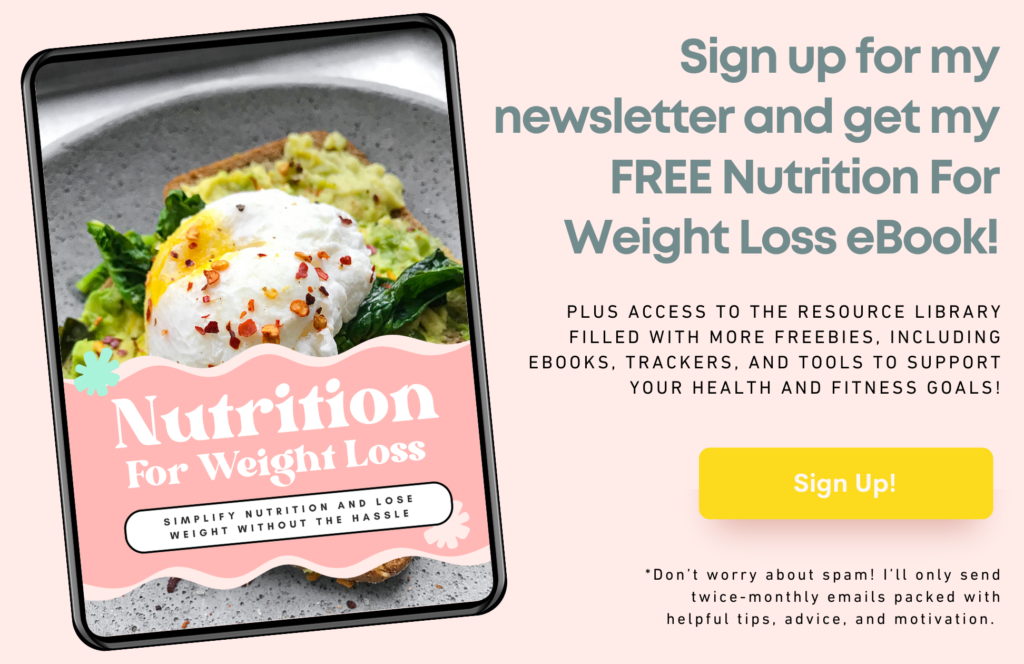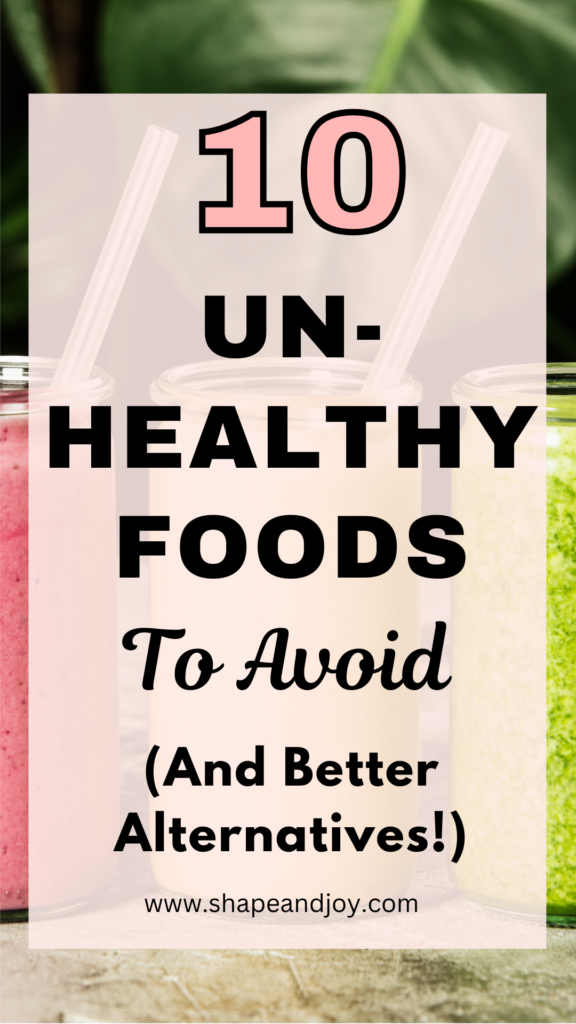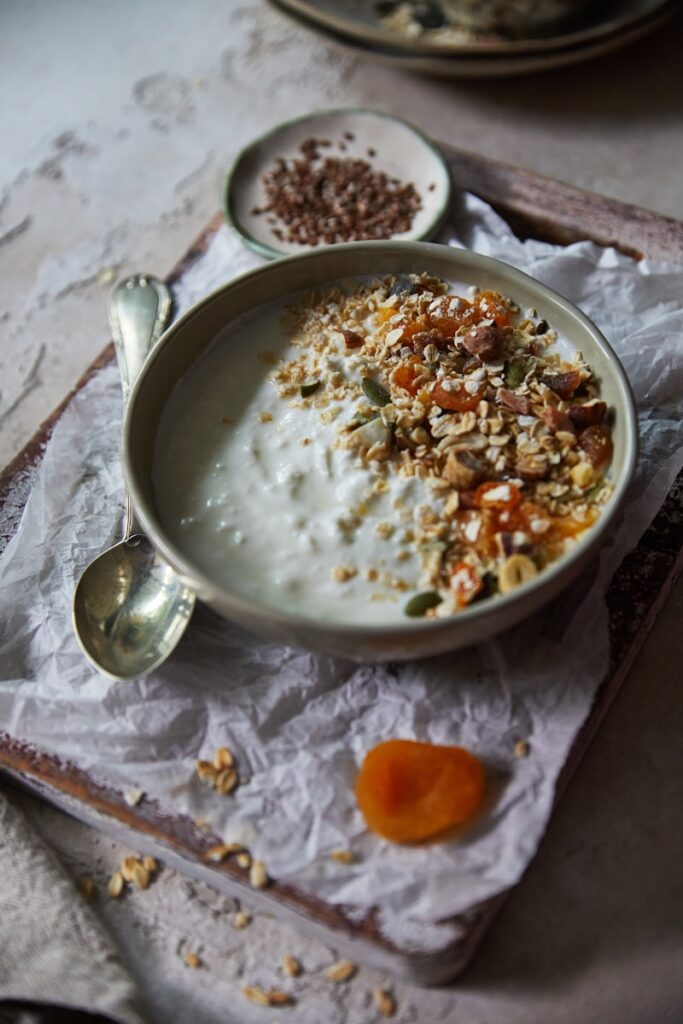This post may contain affiliate links, which means that I may earn a commission if you click on the link or make a purchase using the link. When you make a purchase, the price you pay will be the same whether you use the affiliate link or go directly to the vendor’s website using a non-affiliate link.
Let’s get one thing straight right off the bat: I’m not here to tell you to throw out any of these “unhealthy foods”. Your granola bars are safe and you don’t need to abandon your love for a quick protein-packed snack. If they’re your go-to, keep enjoying them!
Food should be about balance, not deprivation.
However, what really bugs me is how these foods are often marketed. They’re pitched as the ultimate “healthy eating diet” staples, part of some magical no processed food diet, or even essentials for your whole food diet.
But when you dig a little deeper, many of them aren’t as saintly as they seem.
This isn’t about saying no to unhealthy foods—it’s about knowing what’s in them. Whether you’re aiming for a real food diet, looking to avoid processed foods, or just want to understand what are processed foods, I’ve got you covered. Let’s debunk the myths and empower you to make informed choices.

What’s Healthy vs Unhealthy Food, Really?
Let’s take a moment to break down what actually counts as “healthy” and “unhealthy” because, honestly, the lines can get pretty blurry.
It’s not about labelling foods as “good” or “bad” but understanding where they fall on the spectrum.
Whole Foods: These are your MVPs—foods in their natural state, like fruits, veggies, nuts, seeds, and whole grains. Think fresh sweet potatoes, spinach, or almonds. Whole foods are the foundation of a whole food diet, packed with nutrients and as close to nature as you can get.
Lightly Processed Foods: These have been tweaked a bit but still keep their nutritional value intact. Things like frozen veggies, canned beans, or rolled oats are excellent staples for nutrition.

Processed Foods: These have been altered for convenience, with added ingredients like sugar, salt, or oils. Bread, pasta, and flavoured yoghurts fall into this category. While not inherently unhealthy, it’s good to be mindful of what’s added.
Ultra-Processed Foods: These are the big offenders on the “unhealthy foods” list. They’re highly altered with preservatives, additives, and artificial ingredients. Think crisps, fizzy drinks, and instant noodles. These foods often lack the nutrients your body needs and are easy to overconsume.
Here’s the thing: no food needs to be completely off-limits. If you aim for balance, you can enjoy a mix of all these without the guilt trip. That’s where the 80/20 Method comes in.
The 80/20 Method of Eating: A Game-Changer

Here’s the deal: you don’t have to eat “perfectly” to be healthy. The 80/20 method is a flexible approach to eating that focuses on balance rather than extremes.
80% of the time, prioritise nutrient-dense, whole foods—fruits, veggies, good carbs like quinoa or oats, and lean proteins. These foods fuel your body, keep your energy steady, and support long-term health.
20% of the time, enjoy the “unhealthy foods” you love—whether it’s a chocolate bar, takeaway pizza, or that fancy protein bar that tastes suspiciously like dessert. This keeps life enjoyable and helps you stick to your plan without feeling deprived.

The 80/20 method works best when you pair it with mindful eating. It’s not just what you eat but how you eat that matters! Dive into Mindful Eating 101 to learn how to tune into your hunger cues and enjoy food without obsessing over every calorie.
Balance, not perfection, is the key to a healthy eating diet that’s sustainable.
1. Granola Bars: Not quite the non-processed snack you’d think.
Granola bars are marketed as a “natural eating” staple, but many are packed with sugar, syrups, and additives..
My take: If you love them, eat them! They’re great for convenience, and I reach for them a lot as a pre-workout snack. But if you’re after true non-processed foods, check the label or try making your own. Otherwise, grab a handful of nuts or good carbs like a banana—they’ll fill you up without the hidden extras.

If you want to take the guesswork out of planning meals with the right balance of nutrients, macros can be a game-changer. Head over to Meal Planning by Macros: Your Ultimate Guide! to learn how to build meals that fuel your body and satisfy your taste buds.
2. Smoothies and Juices: A sugar fast waiting to happen.
Smoothies are often sold as a “healthy eating” miracle, but pre-made versions are loaded with sugar and stripped of fibre.
My take: Blend your own at home with non-processed foods like whole fruits, veggies, and maybe some spinach for a nutrient boost. Pair it with complex carbs like oats or chia seeds to keep you fuller for longer. If shop-bought smoothies are your thing, just enjoy them as a treat—not your main source of nutrition.

3. Fat-Free Products: Sugar’s sneaky partner.
The fat-free craze might sound like it fits into a healthy eating diet, but here’s the kicker: when fat is removed, sugar and chemicals are usually added.
My take: Don’t fear fat! Full-fat products are part of natural eating and much more satisfying. A little bit of fat in your diet goes a long way, so go for real food options like full-fat Greek yoghurt or avocados. You’ll thank yourself later.
4. Veggie Chips: More processed than you’d think.
Veggie chips scream health food, but don’t be fooled—they’re still fried, salty, and more “crisp”. They might seem like a better choice than regular crisps, but they’re still firmly on the processed food list.
My take: If you’re a fan, go ahead and snack! But for a swap, try roasting your own sweet potato snacks or munching on air-popped popcorn.

5. Store-Bought Salad Dressings: Sweet surprises in disguise.
You’ve made a gorgeous salad with whole foods, but then you drown it in dressing from a bottle. Unfortunately, most store-bought dressings are full of sugar, preservatives, and oils.
My take: If you love your bottled dressing, no judgement—use it! But for a healthier alternative, whip up your own with olive oil, lemon juice, and a touch of honey.
Enjoying this post? Pin it for later!

6. Protein Bars: Delicious but deceptive.
I’m a huge fan of protein bars, but let’s be honest—they’re often closer to candy bars. They’re marketed as healthy, but many are full of sugar and additives.
My take: Enjoy them as a treat or a post-workout snack, but don’t rely on them as a meal replacement. If you’re aiming for a real food diet, go for boiled eggs or a handful of nuts instead.
7. Flavoured Yoghurts: Dessert disguised as breakfast.
Flavoured yoghurts are another food often paraded as part of a healthy eating diet. But the sugar content? It’s closer to a pudding.
My take: If you love your fruity yoghurt, stick with it! But try adding honey or fresh fruit to plain Greek yoghurt—it’s a quick trick that’s just as tasty without the sugar overload.

8. Breakfast Cereals: High-carb foods with little to give back.
Breakfast cereals might be sold as healthy carbs, but most are refined and sugary. Even the “whole-grain” ones can be misleading.
My take: Switch to oats or make your own granola using non-processed foods. They’re cheap, easy, and keep you full for hours.
9. Packaged Smoothie Bowls: Pretty but problematic.
Smoothie bowls look like they belong in a whole foods list, but pre-packaged ones are usually full of sugar and additives that scream processed food.
My take: Make your own at home with frozen bananas, fresh berries, and healthy carbs like granola or chia seeds. It’s cheaper and tastier.

10. Plant-Based Meats: Not all that natural.
Plant-based meats are great for reducing your carbon footprint, but many are ultra-processed and far from whole. They’re often high in sodium and additives, making them more processed food than non-processed food.
My take: Enjoy them if you like, but balance them with whole plant foods like beans, lentils, or tofu. They’re perfect for a natural eating approach.
Conclusion
At the end of the day, food is meant to be enjoyed.
Whether you’re diving into natural eating, trying a sugar fast, or simply cutting back on the unhealthy foods list, remember this:
Balance beats perfection, every time.
If you love granola bars, veggie chips, or a shop-bought smoothie, eat them guilt-free. Just know what you’re getting and keep your diet filled with plenty of real food, good carbs, and the occasional treat.
You’re smashing it—keep going!
If you’ve ever struggled with the binge-restrict cycle or felt trapped by an all-or-nothing mindset, you’re not alone. Understanding the psychology of weight loss is key. Check out Weight Loss Psychology 101 for insights into building a healthy, balanced relationship with food.
Enjoyed this post? Pin it for later!

Unhealthy Foods: Studies
Granola bars can be high in added sugars but reformulating with low-glycaemic sweeteners like honey improves nutrition without sacrificing taste (Ying, 2018).
Commercial smoothies often lack fibre and are loaded with sugar; homemade versions with whole fruits are healthier (Zamora-Gasga et al., 2014).
Fat-free products often replace fat with sugars, making full-fat options like Greek yoghurt a better choice for satiety and nutrition (Stanhope, 2016).
Protein bars frequently contain high sugar levels and should not replace whole-food protein sources (Fernan et al., 2018).
